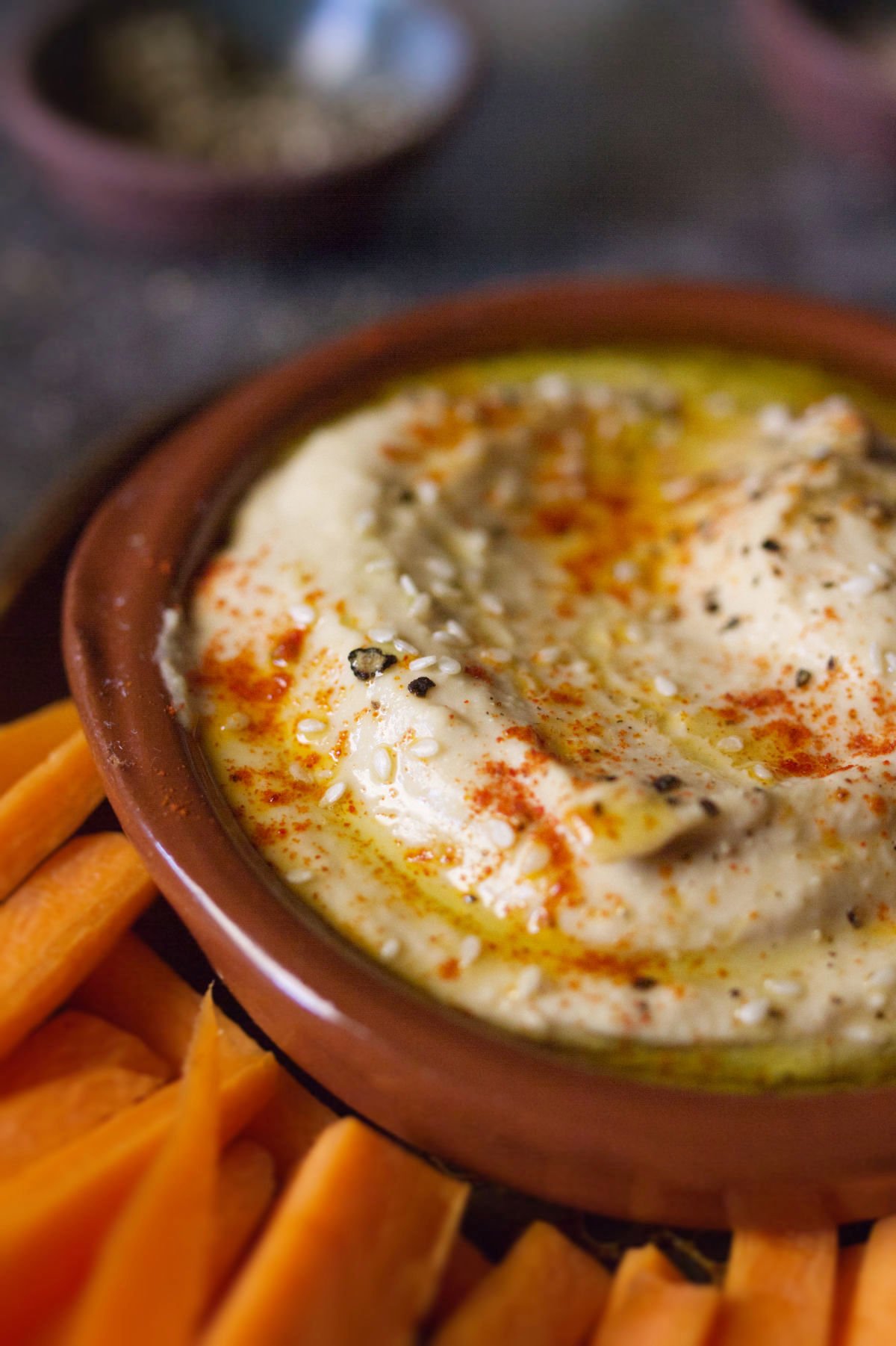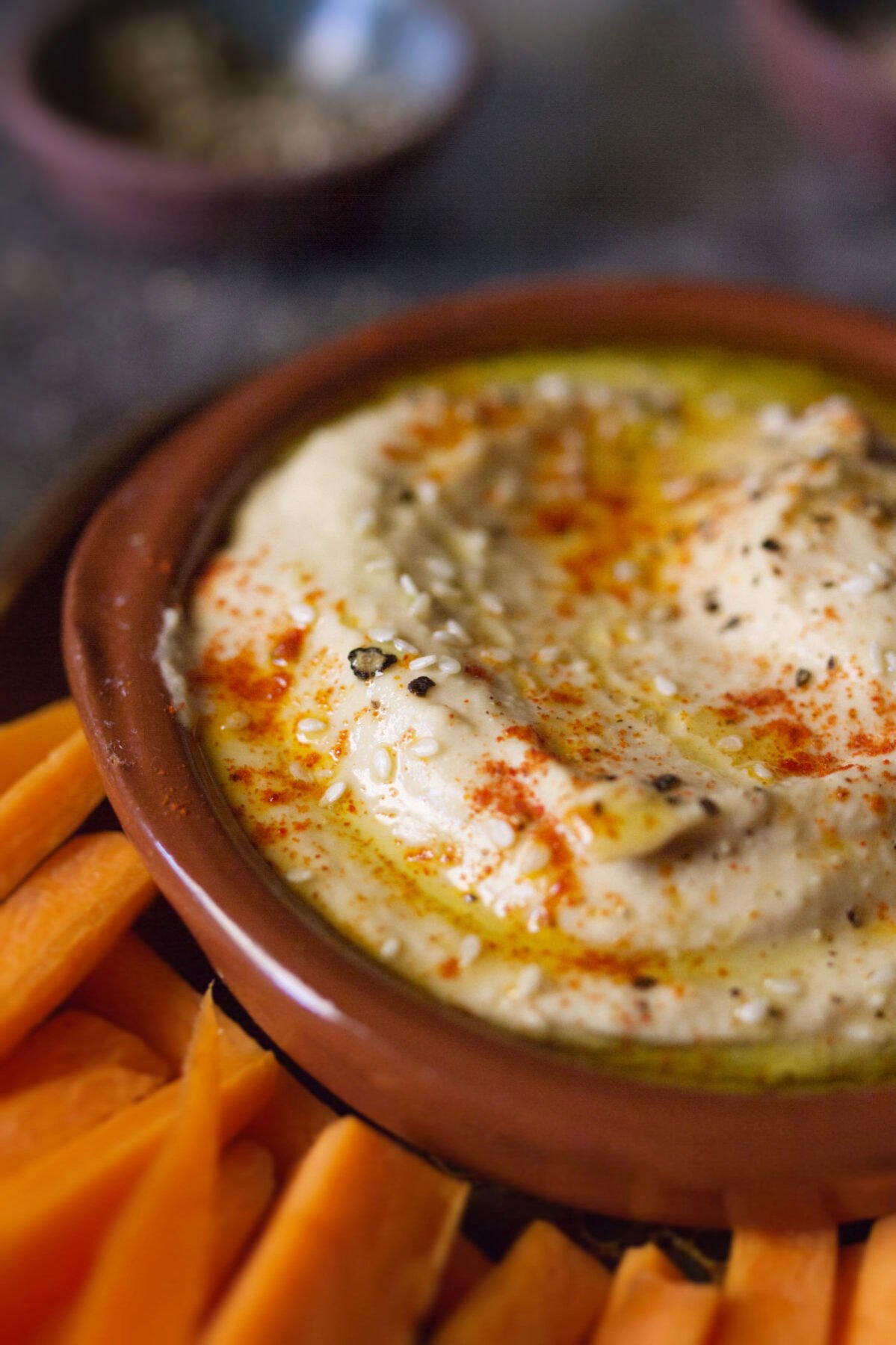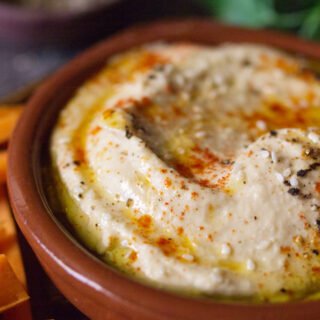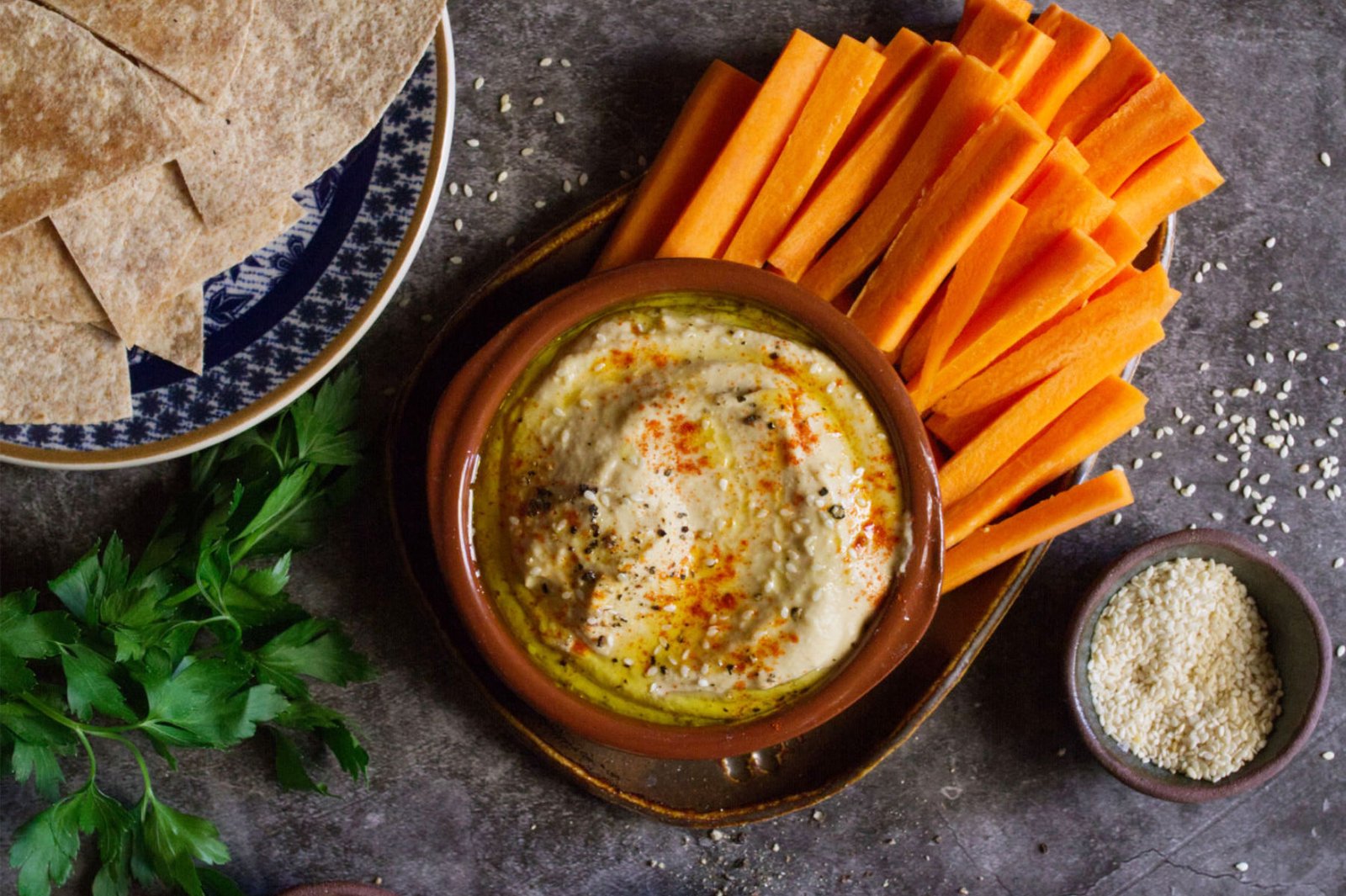Smooth, creamy, and loaded with flavor, this authentic Mediterranean Hummus recipe is the best! It’s healthy, easy to make, and uses a few simple ingredients: tinned chickpeas, tahini, lemon juice, garlic, olive oil, and seasoning. This recipe follows the traditional Mediterranean method of preparation and adds the convenience of modern kitchen equipment, plus it has a few tips to get that extra creamy hummus consistency!
Hummus is super versatile and is something that can be whipped up in an instant when desired. Serve it alongside some warmed pita bread, carrot sticks, or your favorite cracker and you’re halfway to a Mediterranean mezze platter. Hummus is also great as a spread on bread or in sandwiches.
Table of contents:
What is Hummus?
Hummus is a popular dip or spread made from cooked, mashed chickpeas or other beans, blended with tahini (a paste made from sesame seeds), olive oil, lemon juice, salt, and garlic. When made the authentic way, it has a smooth, creamy consistency and is often served as an appetizer with pita bread or vegetables for dipping.
Hummus is not only delicious but also nutritious and good for you. It’s high in protein, an excellent source of fiber, and boasts various vitamins and minerals. It’s enjoyed worldwide as a healthy snack, as a dip or spread, or as a centerpiece to a mezze.
Origins of Hummus
Hummus is believed to have originated in the Levant region of the Middle East, which includes modern-day Syria, Lebanon, Israel, Palestine, and Jordan. The earliest known written recipe for a dish resembling hummus dates back to 13th-century Egypt, though variations of mashed chickpea dishes were in the region for much longer.
Over time, hummus spread throughout the Middle East, the Mediterranean, and beyond, becoming a beloved dish in many countries worldwide.
Why an ‘authentic 5-minute hummus recipe’ does not exist.
An “authentic 5-minute hummus recipe” doesn’t really exist because traditional hummus requires certain steps that cannot be significantly shortened without sacrificing flavor and texture. Here’s why:
- Cooking chickpeas: Traditional hummus is often made from dried chickpeas that need to be soaked overnight and then cooked until they’re soft, which can take around 1-2 hours, depending on the method used.
- Blending: Achieving the creamy texture of hummus requires thorough blending, which takes time. Even with powerful blenders, it takes several minutes to achieve the desired consistency.
- Flavor development: The flavors in hummus need time to meld together. This is an important step and is often neglected in Western interpretations of hummus recipes. Ingredients that need time to meld include the garlic, tahini, lemon juice, and olive oil. Allowing the ingredients to sit together for a while enhances the flavor of the hummus.
- Texture: Properly processed hummus has a smooth and creamy texture. Achieving this texture requires patience in blending and occasionally scraping down the sides of the food processor to ensure everything is evenly mixed. Skimping on blend time leads to chunky hummus that lacks the desired texture.
While there are quicker versions of hummus, and they can still be quite tasty, they often lack the depth of flavor and creamy texture of traditional homemade hummus.
While a “5-minute hummus recipe” might produce something resembling hummus, it would likely not meet the standards of authenticity and quality that many people expect from the dish.

How to Make Authentic Creamy Mediterranean Hummus
Ingredients
- 4 cups cooked chickpeas, drained (keep a little of the liquid ‘aquafaba’ for use later)
- ½ cup tahini
- 2 lemons juiced
- 6 tablespoons iced water
- 2-3 cups warmed water
- 2 garlic cloves, minced
- 1 teaspoon cumin
- 1 teaspoon salt (or to taste)
For Garnish
- Extra-virgin olive oil
- Sweet paprika
- Freshly chopped parsley
Equipment
- 1 large bowl
- Colander
- Food processor
- Lemon squeezer (optional)
- Small bowl, for serving
Instructions
- Add the rinsed and drained chickpeas to a large bowl with some warm water. Scoop the chickpeas between your hands and gently rub them to remove the chickpea skins. Discard the skins and drain the chickpeas. This should take around 5-10 minutes. It is an optional step but it will leave your Hummus with a much more creamy texture.
- To a food processor, add the lemon juice, salt, and minced garlic, and buzz for 30 seconds. The next part is also an optional step, but I suggest leaving your ingredients to meld for at least 5-10 minutes at this stage).
- Add the tahini and buzz again until the mixture is thick and smooth (around 30 seconds).
- With the blender running, add the iced water one tablespoon at a time and buzz until smooth.
- Add the chickpeas (reserve a few chickpeas for garnish) and ground cumin, and buzz again for around 5 minutes, check the texture, and buzz again if required (it should be smooth and creamy).
- If the mixture is too dry, add some chickpea liquid (aquafaba).
- Spoon the hummus into a serving bowl, drizzle with olive oil, add the reserved chickpeas, and a dusting of paprika, season to taste with some salt and cracked black pepper, and garnish with a little fresh parsley.

Cooking Notes
- For best results, allow the garlic, salt, and lemon juice to meld for 10 minutes once blended.
- Garlic and ground cumin are optional and can be omitted for a more pure chickpea-flavored hummus.
- We use canned chickpeas for convenience, but you can use dried chickpeas with a little extra preparation. NOTE: 1 cup of dried chickpeas = 3 cups of soaked and cooked chickpeas.

Can I Use Dried Chickpeas?
Absolutely, and in fact, authentic hummus recipes will use dried chickpeas. The one caveat: Dried chickpeas do require some preparation before they can be used, so plan ahead and start preparing your chickpeas the night before you need to use them.
Here’s how to prepare dried chickpeas:
- First, soak the dried chickpeas in some clean fresh water overnight. The chickpeas will expand around twice their size so add at least double the amount of water to chickpeas in a large bowl.
- Next, drain them from the water and add them to a pot with some fresh water, and bring to a simmer.
- Cook them for around 2 hours for them to soften up. Alternatively, use a slow cooker or pressure cooker to prepare your chickpeas.
Serving Suggestions
Whether you use hummus as a dip, as a sauce for your favorite sandwich or wrap, or use it as the centerpiece to a delicious mezze platter, there are countless delicious ways to enjoy hummus.
Here are some serving suggestions:
- Dip with Vegetables: My personal favorite! Serve hummus as a dip with fresh vegetables such as carrot sticks, cucumber slices, bell pepper strips, cherry tomatoes, or celery sticks. The combination of creamy hummus with crunchy vegetables is both satisfying and nutritious.
- Pita Bread or Chips: Hummus pairs wonderfully with warm pita bread or pita chips. You can cut pita bread into wedges, lightly toast them in the oven, and then dip them into the hummus for a tasty snack or appetizer.
- Spread on Sandwiches or Wraps: Use hummus as a spread in sandwiches or wraps instead of mayonnaise or other condiments. It adds flavor, creaminess, and nutrition to your favorite sandwich fillings, such as roasted vegetables, grilled chicken, falafel, or sliced turkey.
These are just a few ideas to get you started, but feel free to get creative and experiment with different combinations and serving options to suit your taste preferences and dietary needs!

Hummus Recipe Ideas
- Hummus Bowls: Create a hummus bowl by spreading a generous serving of hummus at the bottom of a bowl and topping it with ingredients like roasted chickpeas, diced tomatoes, cucumbers, olives, feta cheese, fresh herbs, and a drizzle of olive oil. Serve with warm pita bread or crackers for dipping.
- Hummus Toast: Spread hummus on whole grain toast and top it with sliced avocado, cherry tomatoes, arugula, or a sprinkle of feta cheese for a nutritious and satisfying breakfast or snack.
- Hummus Stuffed Peppers: Fill halved bell peppers with hummus and top them with chopped vegetables, fresh herbs, or a sprinkle of feta cheese for a colorful and flavorful appetizer or side dish.
Hummus and Grain Salads: Mix hummus into grain salads such as quinoa, couscous, or bulgur wheat for added creaminess and flavor. Combine it with roasted vegetables, chickpeas, fresh herbs, and a squeeze of lemon juice for a delicious and nutritious meal.
Why Hummus is Healthy
Hummus is considered healthy for several reasons:
- Nutrient-rich: Hummus is made primarily from chickpeas, which are packed with nutrients such as protein, fiber, vitamins (including folate, vitamin K, and vitamin C), and minerals (including iron, magnesium, and zinc). These nutrients are essential for overall health and well-being.
- Healthy fats: The addition of olive oil and tahini (sesame seed paste) to hummus provides healthy fats, particularly monounsaturated fats, which are beneficial for heart health. These fats can help lower bad cholesterol levels (LDL cholesterol) and reduce the risk of heart disease.
- Protein: Chickpeas are a good source of plant-based protein, making hummus a good option for vegetarians and vegans looking to increase their protein intake. Protein is essential for muscle repair and growth, as well as for supporting various bodily functions.
- Fiber: Both chickpeas and tahini are rich in fiber, which is important for digestive health. Fiber helps promote regular bowel movements, prevents constipation, and may also help lower cholesterol levels and regulate blood sugar levels.
- Antioxidants: Chickpeas and tahini contain antioxidants, such as flavonoids and phenolic compounds, which help protect cells from damage caused by harmful free radicals. Antioxidants play a role in reducing inflammation and lowering the risk of chronic diseases, including certain cancers and cardiovascular diseases.
- Versatility: Hummus can be enjoyed in various ways, such as a dip for vegetables or whole grain crackers, as a spread in sandwiches or wraps, or as a topping for salads or grilled meats. Its versatility makes it easy to incorporate into a balanced and nutritious diet.
- Low GI: Chickpeas have a relatively low GI, typically ranging from around 28 to 42, depending on a few factors (cooking method, other ingredients used). This means that chickpeas are less likely to cause rapid spikes in blood sugar levels compared to high-GI foods.
Hummus Nutrition Facts
| Servings: 8 | |
| Amount per serving | |
| Calories | 205 |
| % Daily Value* | |
| Total Fat 6.6g | 8% |
| Saturated Fat 0.6g | 3% |
| Cholesterol 0mg | 0% |
| Sodium 159mg | 7% |
| Total Carbohydrate 29.9g | 11% |
| Dietary Fiber 7.9g | 28% |
| Total Sugars 4.8g | |
| Protein 10.3g | |
| Vitamin D 0mcg | 0% |
| Calcium 158mg | 12% |
| Iron 11mg | 60% |
| Potassium 468mg | 10% |
| *The % Daily Value (DV) tells you how much a nutrient in a food serving contributes to a daily diet. 2,000 calorie a day is used for general nutrition advice. | |

Creamy Mediterranean Hummus | Easy & Healthy Recipe
Equipment
- 1 Large bowl
- Colander
- Food processor
- Lemon squeezer (optional)
- Small bowl, for serving
Ingredients
- 4 cups cooked chickpeas drained (keep a little of the liquid ‘aquafaba’ for use later)
- ½ cup tahini
- 2 lemons juiced
- 6 tablespoons iced water
- 2-3 cups warmed water
- 2 garlic cloves minced
- 1 teaspoon cumin
- 1 teaspoon salt or to taste
For Garnish
- Extra-virgin olive oil
- Sweet paprika
- Freshly chopped parsley
Instructions
- Add the rinsed and drained chickpeas to a large bowl with some warm water. Scoop the chickpeas between your hands and gently rub them to remove the chickpea skins. Discard the skins and drain the chickpeas. This should take around 5-10 minutes. It is an optional step but it will leave your Hummus with a much more creamy texture.4 cups cooked chickpeas, 2-3 cups warmed water
- To a food processor, add the lemon juice, salt, and minced garlic, and buzz for 30 seconds. The next part is also an optional step, but I suggest leaving your ingredients to meld for at least 5-10 minutes at this stage).2 lemons juiced, 2 garlic cloves, 1 teaspoon salt
- Add the tahini and buzz again until the mixture is thick and smooth (around 30 seconds).½ cup tahini
- With the blender running, add the iced water one tablespoon at a time and buzz until smooth.6 tablespoons iced water
- Add the chickpeas (reserve a few chickpeas for garnish) and ground cumin, and buzz again for around 5 minutes, check the texture, and buzz again if required (it should be smooth and creamy).1 teaspoon cumin
- If the mixture is too dry, add some chickpea liquid (aquafaba).
- Spoon the hummus into a serving bowl, drizzle with olive oil, add the reserved chickpeas, and a dusting of paprika, season to taste with some salt and cracked black pepper, and garnish with a little fresh parsley.Extra-virgin olive oil, Sweet paprika, Freshly chopped parsley
Video
Notes
Cooking Notes
- For best results, allow the garlic, salt, and lemon juice to meld for 10 minutes once blended.
- Garlic and ground cumin are optional and can be omitted for a more pure chickpea-flavored hummus.
- We use canned chickpeas for convenience, but you can use dried chickpeas with a little extra preparation. NOTE: 1 cup of dried chickpeas = 3 cups of soaked and cooked chickpeas.


Leave a Reply